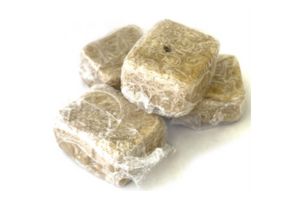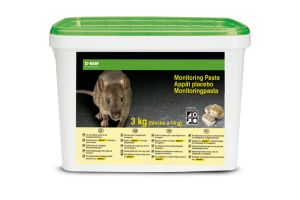Is monitoring an essential part of rodent control?
Every farmer will be all too familiar with the challenges of preventing and tackling tricky rodent infestations across their site. And with the demanding day-to-day running of a farm, sometimes rodent control/pest control can slip to the bottom of the priority list, meaning early activity can go unnoticed and infestations soon establish.
One of the most underutilised tools in a farmer’s armoury, though, is monitoring bait. Usually formulated (although not exclusive) to blocks, non-toxic baits are made from a blend of food-grade ingredients that rodents find attractive. They are designed to be appealing to rodents, thus making it easier for farmers to monitor rodent activity.
These non-toxic tools are becoming increasingly popular within the industry and with auditors alike. Many are formulated using the same highly-palatable ingredients as their chemical counterpart, but without the active ingredient, such as Selontra® and Monitoring Paste by BASF, ensuring that when switching from the non-toxic to the toxic the rodent is more likely to think it’s the same food source.
In years gone by, and perhaps to an extent still to this day, the use of monitoring products has been considered a waste of time and money by many farmers and only used when required by auditors. However, as time moves on and the industry becomes more considerate with rodenticide use, many are now discovering the numerous benefits of adding monitoring products to their Integrated Pest Management (IPM) programme.
Previously, farmers may have simply relied on baiting permanently or discovering physical evidence such as droppings, runs and signs of damage, when carrying out site inspections. Some may even use tracking dust, sand, or flour along suspected activity areas. So, what are the benefits of using a monitoring bait?
1. Detect infestations early
Monitoring products are key to helping farmers detect early signs of rodent activity and get ahead of potential challenging infestations. When an infestation is just taking hold, and little may be noticed through a visual inspection, the use of non-toxic monitoring products allows individuals to easily track rodent activity and determine the extent of the infestation.
Monitoring blocks, such as Monitoring Paste by BASF, act as a first indicator that a site has early signs of rodent activity, with rats and mice making the most of having a highly palatable and easily accessible food source on hand. This allows a farmer to act fast and put an effective treatment programme in place quickly to prevent the infestation from establishing, saving them time and money and preventing loss of earnings through contamination.
2. Monitoring encourages rodenticide uptake
Rodents are notorious for being wary of new objects in their environment, so putting a rodenticide down when early activity is detected can result in a delayed take. By using monitoring baits, rodents in the area will become more familiar with the object, reducing neophobia when the monitoring baits are replaced with rodenticide, should a chemical control method be required.

3. Save money on wasted bait
Before an infestation takes hold, it can be difficult to know exactly where rodents may come from and how they may move around a site. In many cases, a lot of farmers choose to permanently bait in all boxes. These actions from an environmental perspective can be difficult to justify, and also very costly. Over time if there is no activity on site, the farmer will still have to replace the rodenticide as it will start to go mouldy and be unappealing to rodents, or worse, be demolished by slugs and snails. By using monitoring blocks at these sites, rodents will readily eat them if they appear, giving that early indication, and if they don’t appear then the cost of replacing mouldy monitoring blocks is insignificant compared to its toxic counterpart.
4. Target your baiting programme
Plenty of farmers have areas of their land where they rarely get activity and those that are regularly affected by rodent activity. By changing their approach to monitoring and having toxic bait in situ at those regularly affected areas, they can target their treatment appropriately rather than blanket treating the whole site. This methodology can allow farmers to employ a more targeted approach when treating an infestation, whilst saving them money and reducing the exposure of non-target rodents as per the CRRU guidance.
5. Instant take by using the right pairing
There are many monitoring products that have the same ingredients and construction as its toxic counterpart. Monitoring Paste by BASF features a non-toxic soft block formulation that is based on the highly palatable, award-winning rodenticide Selontra®, with the active and dye taken out.
Using a monitoring block that has a sister toxic product will ensure you get rapid control if an issue occurs. In all of BASF’s testing and field trails, there was instant uptake from rats and mice when Monitoring Paste was switched to the toxic product, as the rodents assumed it was the same food source.
This approach to monitoring can mean your treatment time is massively reduced comparatively from starting from scratch or using alternative products.

Monitoring options and placementThere’s no real right or wrong to the placement of monitoring blocks. Farmers will already have a good idea of where rodents may travel around their site and should place stations accordingly. You could also choose to discreetly wire or place monitoring products outside of stations, but it is worth bearing in mind that when you do get activity you’ll need to place the toxic bait in the same manner for speed of control, which may not always be practical when placed outside of bait stations. Therefore, if the monitoring blocks are placed in bait boxes or where it can be placed “covered and protected”, then they can be directly replaced with the toxic bait when and if necessary.
Of course, monitoring blocks are not the only tool at the farmer’s disposal. With technology becoming increasingly sophisticated, there is also the option to monitor activity digitally, using cameras, trapping systems and box sensors. However, this technology in pest control is early and can be unreliable at times, and investing in this kind of equipment can be costly.
For more information visit https://www.pestcontrol.basf.co.uk/en/ |
|
For more expert advice on rural rodent control, and to find out more about BASF’s rodent control solutions, visit https://www.pestcontrol.basf.co.uk/en/Urban-and-Rural-Pest-Control/Rural-Pest-Control/ |
- Log in to post comments

